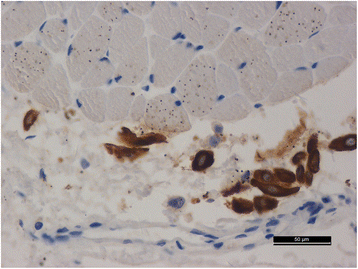A fatal case of severe neck abscess due to a third branchial cleft fistula: morphologic and immunohistochemical analyses
- PMID: 27628180
- PMCID: PMC5024451
- DOI: 10.1186/s13000-016-0540-0
A fatal case of severe neck abscess due to a third branchial cleft fistula: morphologic and immunohistochemical analyses
Abstract
Background: Branchial cleft anomalies constitute a frequently encountered and commonly non-lethal disease in otolaryngology, and result from aberrant embryonic development. The third branchial cleft fistula is one of the four known specific types of branchial cleft anomalies, and always presents as recurrent neck abscess and suppurative thyroiditis. Here, we report an unexpected death due to severe neck infection following a third branchial cleft fistula.
Case presentation: A 19-year-old man was sent to the hospital with a 1-week history of recurrent left-sided neck abscess, and was scheduled for incision and drainage of the abscess. However, before the surgery was performed, the man's condition deteriorated and he died. A review of his medical history showed that he had undergone a previous incision and drainage for a neck abscess 2 years ago. Postmortem examination revealed that the fatal neck abscess was induced by a third branchial cleft fistula.
Conclusions: We conclude that a histopathological examination of neck tissue combined with a detailed review of medical history and examination of ultrasonographic and CT images can provide a rapid and accurate diagnosis of third branchial cleft fistula. This common, non-lethal disease can potentially lead to death if the neck infection is not properly diagnosed and treated. In medico-legal practice, medical examiners should be aware of this condition, as this knowledge would be important in the diagnosis of the cause of death.
Keywords: Branchial cleft anomaly; Immunohistochemistry; Neck abscess; Third branchial cleft fistula.
Figures





References
-
- Aneeza WH, Mazita A, Marina MB, Razif MY. Complete congenital third branchial fistula: does the theoretical course apply? Singap Med J. 2010;51:e122–5. - PubMed
Publication types
MeSH terms
Supplementary concepts
LinkOut - more resources
Full Text Sources
Other Literature Sources
Medical

